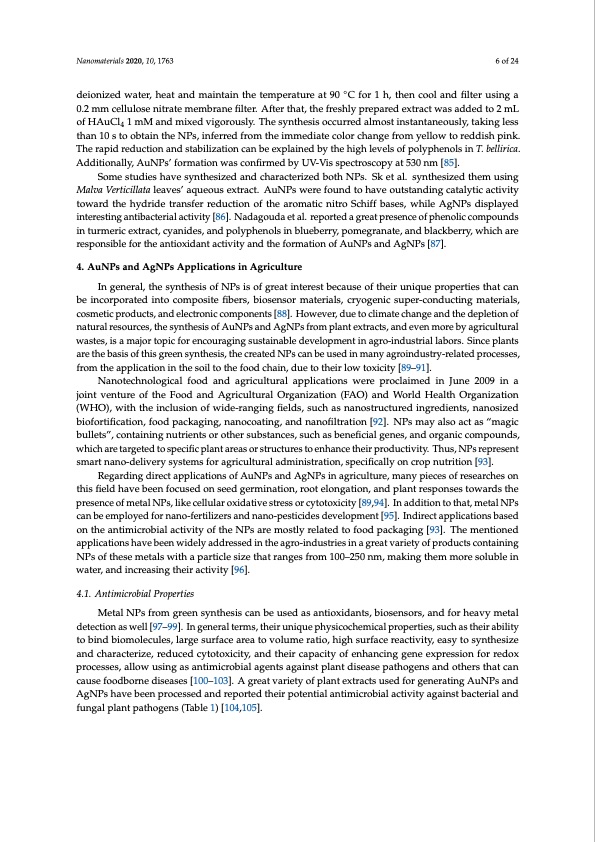
PDF Publication Title:
Text from PDF Page: 006
Nanomaterials 2020, 10, 1763 6 of 24 deionized water, heat and maintain the temperature at 90 ◦C for 1 h, then cool and filter using a 0.2 mm cellulose nitrate membrane filter. After that, the freshly prepared extract was added to 2 mL of HAuCl4 1 mM and mixed vigorously. The synthesis occurred almost instantaneously, taking less than 10 s to obtain the NPs, inferred from the immediate color change from yellow to reddish pink. The rapid reduction and stabilization can be explained by the high levels of polyphenols in T. bellirica. Additionally, AuNPs’ formation was confirmed by UV-Vis spectroscopy at 530 nm [85]. Some studies have synthesized and characterized both NPs. Sk et al. synthesized them using Malva Verticillata leaves’ aqueous extract. AuNPs were found to have outstanding catalytic activity toward the hydride transfer reduction of the aromatic nitro Schiff bases, while AgNPs displayed interesting antibacterial activity [86]. Nadagouda et al. reported a great presence of phenolic compounds in turmeric extract, cyanides, and polyphenols in blueberry, pomegranate, and blackberry, which are responsible for the antioxidant activity and the formation of AuNPs and AgNPs [87]. 4. AuNPs and AgNPs Applications in Agriculture In general, the synthesis of NPs is of great interest because of their unique properties that can be incorporated into composite fibers, biosensor materials, cryogenic super-conducting materials, cosmetic products, and electronic components [88]. However, due to climate change and the depletion of natural resources, the synthesis of AuNPs and AgNPs from plant extracts, and even more by agricultural wastes, is a major topic for encouraging sustainable development in agro-industrial labors. Since plants are the basis of this green synthesis, the created NPs can be used in many agroindustry-related processes, from the application in the soil to the food chain, due to their low toxicity [89–91]. Nanotechnological food and agricultural applications were proclaimed in June 2009 in a joint venture of the Food and Agricultural Organization (FAO) and World Health Organization (WHO), with the inclusion of wide-ranging fields, such as nanostructured ingredients, nanosized biofortification, food packaging, nanocoating, and nanofiltration [92]. NPs may also act as “magic bullets”, containing nutrients or other substances, such as beneficial genes, and organic compounds, which are targeted to specific plant areas or structures to enhance their productivity. Thus, NPs represent smart nano-delivery systems for agricultural administration, specifically on crop nutrition [93]. Regarding direct applications of AuNPs and AgNPs in agriculture, many pieces of researches on this field have been focused on seed germination, root elongation, and plant responses towards the presence of metal NPs, like cellular oxidative stress or cytotoxicity [89,94]. In addition to that, metal NPs can be employed for nano-fertilizers and nano-pesticides development [95]. Indirect applications based on the antimicrobial activity of the NPs are mostly related to food packaging [93]. The mentioned applications have been widely addressed in the agro-industries in a great variety of products containing NPs of these metals with a particle size that ranges from 100–250 nm, making them more soluble in water, and increasing their activity [96]. 4.1. Antimicrobial Properties Metal NPs from green synthesis can be used as antioxidants, biosensors, and for heavy metal detection as well [97–99]. In general terms, their unique physicochemical properties, such as their ability to bind biomolecules, large surface area to volume ratio, high surface reactivity, easy to synthesize and characterize, reduced cytotoxicity, and their capacity of enhancing gene expression for redox processes, allow using as antimicrobial agents against plant disease pathogens and others that can cause foodborne diseases [100–103]. A great variety of plant extracts used for generating AuNPs and AgNPs have been processed and reported their potential antimicrobial activity against bacterial and fungal plant pathogens (Table 1) [104,105].PDF Image | Green Synthesis of Gold and Silver Nanoparticles from Plant Extracts

PDF Search Title:
Green Synthesis of Gold and Silver Nanoparticles from Plant ExtractsOriginal File Name Searched:
nanomaterials-10-01763.pdfDIY PDF Search: Google It | Yahoo | Bing
Turbine and System Plans CAD CAM: Special for this month, any plans are $10,000 for complete Cad/Cam blueprints. License is for one build. Try before you buy a production license. More Info
Waste Heat Power Technology: Organic Rankine Cycle uses waste heat to make electricity, shaft horsepower and cooling. More Info
All Turbine and System Products: Infinity Turbine ORD systems, turbine generator sets, build plans and more to use your waste heat from 30C to 100C. More Info
CO2 Phase Change Demonstrator: CO2 goes supercritical at 30 C. This is a experimental platform which you can use to demonstrate phase change with low heat. Includes integration area for small CO2 turbine, static generator, and more. This can also be used for a GTL Gas to Liquids experimental platform. More Info
Introducing the Infinity Turbine Products Infinity Turbine develops and builds systems for making power from waste heat. It also is working on innovative strategies for storing, making, and deploying energy. More Info
Need Strategy? Use our Consulting and analyst services Infinity Turbine LLC is pleased to announce its consulting and analyst services. We have worked in the renewable energy industry as a researcher, developing sales and markets, along with may inventions and innovations. More Info
Made in USA with Global Energy Millennial Web Engine These pages were made with the Global Energy Web PDF Engine using Filemaker (Claris) software.
Infinity Turbine Developing Spinning Disc Reactor SDR or Spinning Disc Reactors reduce processing time for liquid production of Silver Nanoparticles.
| CONTACT TEL: 608-238-6001 Email: greg@infinityturbine.com | RSS | AMP |